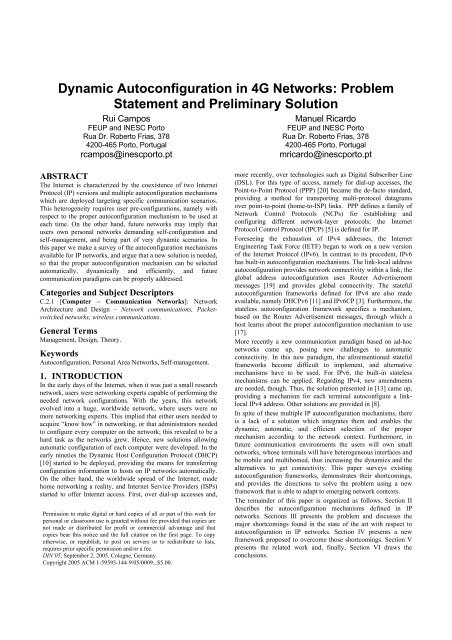Dynamic Autoconfiguration in 4G Networks: Problem Statement and ...
Dynamic Autoconfiguration in 4G Networks: Problem Statement and ...
Dynamic Autoconfiguration in 4G Networks: Problem Statement and ...
- TAGS
- dynamic
- autoconfiguration
You also want an ePaper? Increase the reach of your titles
YUMPU automatically turns print PDFs into web optimized ePapers that Google loves.
Nevertheless, the node implement<strong>in</strong>g the TurfNet gateway <strong>in</strong>sidethe PAN would have to change accord<strong>in</strong>g to the differentTurfNets the PAN would compose with along the time; currentlythe TurfNet framework does not support this.ANs <strong>and</strong> Composition. Consider<strong>in</strong>g a scenario similar to ours, <strong>in</strong>[2] a solution enabl<strong>in</strong>g automatic <strong>and</strong> dynamic creation of a PAN<strong>and</strong> selection of the proper access network is provided. Thesolution is based on the Ambient Network (AN) <strong>and</strong> NetworkComposition concepts be<strong>in</strong>g studied <strong>in</strong> the European project WWIAmbient <strong>Networks</strong> [6]. Nonetheless, this solution just concernsabout IPv6 <strong>and</strong> does not address the heterogeneity com<strong>in</strong>g up withcoexistence of IPv4 <strong>and</strong> IPv6 <strong>in</strong> the current Internet. Therefore, itjust solves part of the problem presented <strong>in</strong> Section 3.MANETs autoconfiguration mechanisms. The IETF MANETAUTOCONF work<strong>in</strong>g group addresses autoconfiguration <strong>in</strong>Mobile Ad-hoc <strong>Networks</strong> (MANETs). This group is search<strong>in</strong>g fora st<strong>and</strong>ard autoconfiguration solution for MANETs, where eachterm<strong>in</strong>al is always act<strong>in</strong>g as a router <strong>and</strong> runn<strong>in</strong>g a rout<strong>in</strong>gprotocol to ma<strong>in</strong>ta<strong>in</strong> IP connectivity with the other term<strong>in</strong>als <strong>in</strong>the same MANET. Some autoconfiguration protocols forMANETs are already def<strong>in</strong>ed [8], <strong>and</strong> certa<strong>in</strong>ly the IETF solutionwill be <strong>in</strong>fluenced by them. In contrast with our solution,MANETs require that each term<strong>in</strong>al acts as a router; <strong>in</strong> ourapproach term<strong>in</strong>als may assume different roles along the timeaccord<strong>in</strong>g to the network context, <strong>and</strong> their <strong>in</strong>teraction is based onoffered <strong>and</strong> required services. Furthermore, current MANETsautoconfiguration <strong>and</strong> rout<strong>in</strong>g protocols suffer from a problemmentioned before: separate solutions are provided concern<strong>in</strong>geach IP version, <strong>and</strong> there is no mechanism enabl<strong>in</strong>g the selectionof a proper framework consider<strong>in</strong>g the network context.6. FURTHER WORKThis paper focused on the autoconfiguration of IP nodes for nextgeneration networks. Other issues that could be considered<strong>in</strong>clude mobility, multihom<strong>in</strong>g, <strong>and</strong> security. These problems arepartially solved by exist<strong>in</strong>g frameworks, such as Mobile IP, whichcan be used <strong>in</strong> conjunction with MAF. Regard<strong>in</strong>gautoconfiguration, work on the l<strong>in</strong>k layer still rema<strong>in</strong>s to be done.For <strong>in</strong>stance, authentication <strong>in</strong> wireless LANs raises newautoconfiguration problems that need to be solved before thenetwork layer autoconfiguration can be accomplished. On theother h<strong>and</strong>, MAF needs to be fully specified <strong>and</strong> validated. Asdef<strong>in</strong>ed now, it does not guarantee session cont<strong>in</strong>uity, <strong>and</strong> theusers will notice service <strong>in</strong>terruption everytime the access IPnetwork changes. The development of a prototype enabl<strong>in</strong>g theproof of concept <strong>and</strong> the evaluation of the Meta-<strong>Autoconfiguration</strong> Framework (MAF) will be the next step of ourwork.7. CONCLUSIONSIn current IP networks two versions of the same protocol coexist.On the other h<strong>and</strong>, multiple autoconfiguration frameworksassociated to each version are def<strong>in</strong>ed, lead<strong>in</strong>g to heterogeneousenvironments. In this scenario, user <strong>in</strong>tervention may be requiredto perform tasks that should be done automatically. Furthermore,exist<strong>in</strong>g autoconfiguration frameworks are not sufficient bythemselves to enable autoconfiguration <strong>in</strong> future dynamiccommunication scenarios, where users will own small networks,<strong>in</strong>stead of s<strong>in</strong>gle term<strong>in</strong>als. This paper analysed the shortcom<strong>in</strong>gsassociated to the state of art of autoconfiguration mechanisms. Weconcluded that there is a lack of an <strong>in</strong>tegrat<strong>in</strong>g solution capable ofunify<strong>in</strong>g the autoconfiguration mechanisms available <strong>and</strong>autoconfigur<strong>in</strong>g nodes <strong>and</strong> start network services accord<strong>in</strong>g tonetwork contexts. In order to improve the current scenario, a newframework was discussed, which enables the <strong>in</strong>tegration ofcurrent autoconfiguration mechanisms <strong>and</strong> addresses the newcommunication paradigms illustrated by the example scenarioprovided.8. ACKNOWLEDGEMENTThe first author would like to thank the support from FCT underthe fellowship SFRH/BD/19429/2004/.9. REFERENCES[1] 3GPP TS 23.060, General Packet Radio Service (GPRS)Service description Stage 2, v6.8.0, March 2005.[2] C. Kappler, N. Akhtar, R. Campos et al., NetworkComposition us<strong>in</strong>g Exist<strong>in</strong>g <strong>and</strong> New Technologies, <strong>in</strong>Proceed<strong>in</strong>gs of the14th IST Mobile & WirelessCommunications Summit 2005, Dresden, Germany, June 19-23, 2005.[3] D. Hask<strong>in</strong>, et al., IP Version 6 over PPP, RFC 2472,December 1998.[4] D. Sönnerstam, et al., Specification of the Bluetooth System(version 1.2), November 2003.[5] G. McGregor, The PPP Internet Protocol Control Protocol(IPCP), RFC 1332, May 1992.[6] http://www.ambient-networks.org/[7] http://www.zeroconf.org[8] K. Weniger, et al., Address <strong>Autoconfiguration</strong> <strong>in</strong> Mobile AdHoc <strong>Networks</strong>: Current Approaches <strong>and</strong> Future Directions,IEEE Network, vol. 18, (August 2004), 6-11.[9] P. Srisuresh, et al., IP Network Address Translator (NAT)Term<strong>in</strong>ology <strong>and</strong> Considerations, RFC 2663, August 1999.[10] R. Droms, <strong>Dynamic</strong> Host Configuration Protocol, RFC2131, 1997.[11] R. Droms, et al., <strong>Dynamic</strong> Host Configuration Protocol forIPv6 (DHCPv6), RFC 3315, July 2003.[12] R. Droms, Stateless <strong>Dynamic</strong> Host Configuration Protocol(DHCP) Service for IPv6, RFC 3736, April 2004.[13] S. Cheshire, et al., <strong>Dynamic</strong> Configuration of IPv4 L<strong>in</strong>k-Local Addresses, RFC 3927, May 2005.[14] S. Cheshire, et al., Multicast DNS, Internet Draft, draftcheshire-dnsext-multicastdns-05(work <strong>in</strong> progress), July2005.[15] S. Cobb, PPP Internet Protocol Control Protocol Extensionsfor Name Server Addresses, RFC 1877, December 1995.[16] S. Schmid, et al., TurfNet: An Architecture for <strong>Dynamic</strong>allyComposable <strong>Networks</strong>, <strong>in</strong> Proceed<strong>in</strong>gs of the First IFIP TC6WG6.6 International Workshop on AutonomicCommunication, Berl<strong>in</strong>, Germany, October 2004.[17] S. Thomson, et al., IPv6 Stateless Address<strong>Autoconfiguration</strong>, RFC 2462, December 1998.[18] T. Chown, et al., DHCP: IPv4 <strong>and</strong> IPv6 Dual-Stack Issues,Internet Draft, draft-ietf-dhc-dual-stack-03 (work <strong>in</strong>progress), July 2005.[19] T. Narten, et al., Neighbor Discovery for IP Version 6(IPv6), RFC 2461, December 1998.[20] W. Simpson, Ed., The Po<strong>in</strong>t-to-Po<strong>in</strong>t Protocol (PPP), RFC1661, July 1994





